Silver Fern Farm: Strategic Analysis and Improvement Initiatives
VerifiedAdded on 2023/06/04
|23
|6020
|206
Report
AI Summary
This report provides a comprehensive strategic analysis of Silver Fern Farm, a New Zealand-based company in the red meat industry. It begins with an executive summary and background, followed by an overview of the company's top executives and business model. The report then delves into an environmental analysis, examining the industry's competitive landscape, including the threat of new entrants, buyer and supplier bargaining power, and profitability. It also analyzes the macro-environment, including political, economic, social, and technological factors. Further, the report assesses the organization's mission, vision, core values, and core competencies, identifying current problems and analyzing functional strategies. Improvement initiatives are discussed, along with their previous and current impact, and alignment with strategic management. Finally, strategic options are evaluated, leading to a recommendation for the best strategic approach for Silver Fern Farm.

Silver Fern Farm 1
Name
Student ID
Lecture name
SILVER FERN FARM
1
Name
Student ID
Lecture name
SILVER FERN FARM
1
Paraphrase This Document
Need a fresh take? Get an instant paraphrase of this document with our AI Paraphraser
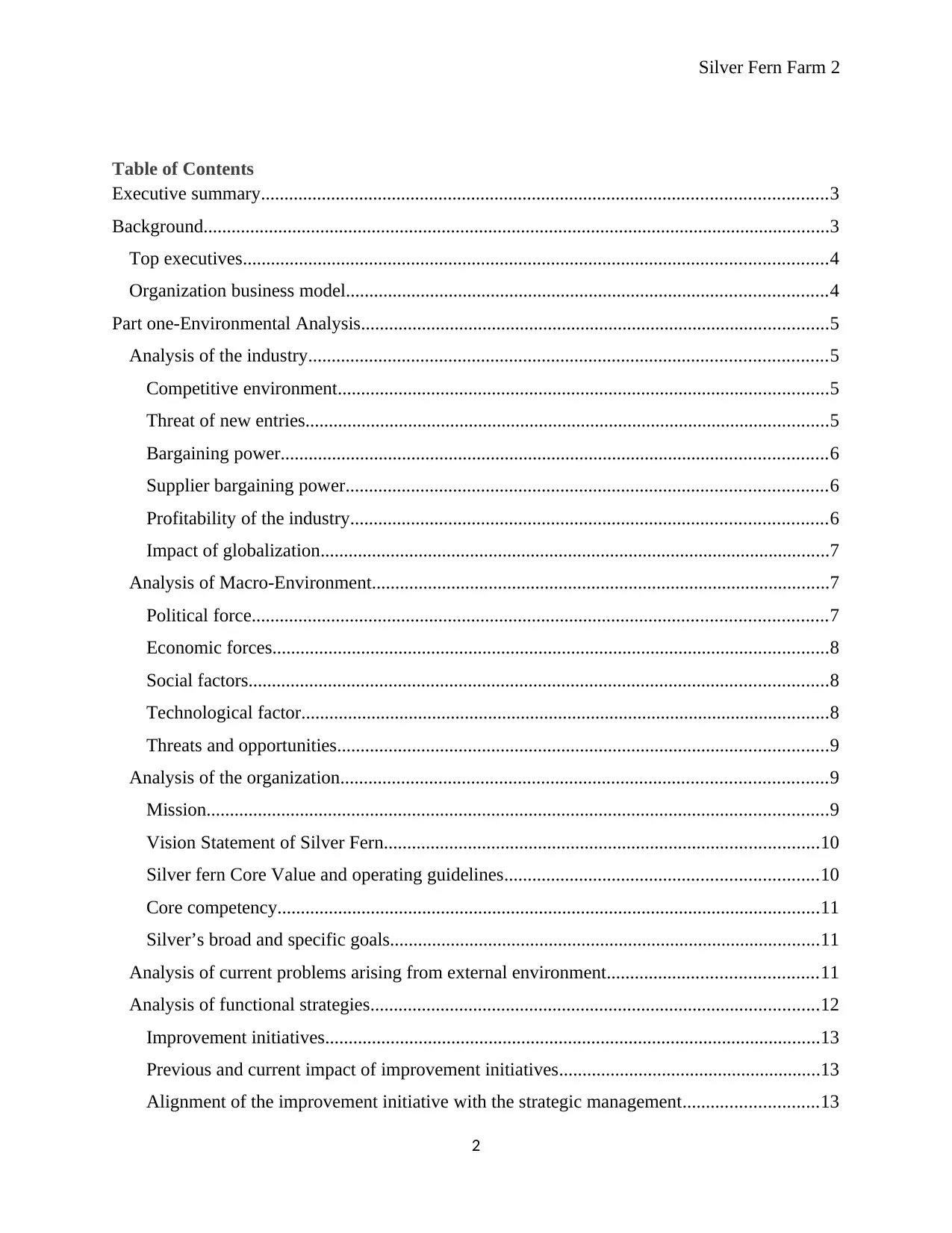
Silver Fern Farm 2
Table of Contents
Executive summary.........................................................................................................................3
Background......................................................................................................................................3
Top executives.............................................................................................................................4
Organization business model.......................................................................................................4
Part one-Environmental Analysis....................................................................................................5
Analysis of the industry...............................................................................................................5
Competitive environment.........................................................................................................5
Threat of new entries................................................................................................................5
Bargaining power.....................................................................................................................6
Supplier bargaining power.......................................................................................................6
Profitability of the industry......................................................................................................6
Impact of globalization.............................................................................................................7
Analysis of Macro-Environment..................................................................................................7
Political force...........................................................................................................................7
Economic forces.......................................................................................................................8
Social factors............................................................................................................................8
Technological factor.................................................................................................................8
Threats and opportunities.........................................................................................................9
Analysis of the organization........................................................................................................9
Mission.....................................................................................................................................9
Vision Statement of Silver Fern.............................................................................................10
Silver fern Core Value and operating guidelines...................................................................10
Core competency....................................................................................................................11
Silver’s broad and specific goals............................................................................................11
Analysis of current problems arising from external environment.............................................11
Analysis of functional strategies................................................................................................12
Improvement initiatives..........................................................................................................13
Previous and current impact of improvement initiatives........................................................13
Alignment of the improvement initiative with the strategic management.............................13
2
Table of Contents
Executive summary.........................................................................................................................3
Background......................................................................................................................................3
Top executives.............................................................................................................................4
Organization business model.......................................................................................................4
Part one-Environmental Analysis....................................................................................................5
Analysis of the industry...............................................................................................................5
Competitive environment.........................................................................................................5
Threat of new entries................................................................................................................5
Bargaining power.....................................................................................................................6
Supplier bargaining power.......................................................................................................6
Profitability of the industry......................................................................................................6
Impact of globalization.............................................................................................................7
Analysis of Macro-Environment..................................................................................................7
Political force...........................................................................................................................7
Economic forces.......................................................................................................................8
Social factors............................................................................................................................8
Technological factor.................................................................................................................8
Threats and opportunities.........................................................................................................9
Analysis of the organization........................................................................................................9
Mission.....................................................................................................................................9
Vision Statement of Silver Fern.............................................................................................10
Silver fern Core Value and operating guidelines...................................................................10
Core competency....................................................................................................................11
Silver’s broad and specific goals............................................................................................11
Analysis of current problems arising from external environment.............................................11
Analysis of functional strategies................................................................................................12
Improvement initiatives..........................................................................................................13
Previous and current impact of improvement initiatives........................................................13
Alignment of the improvement initiative with the strategic management.............................13
2
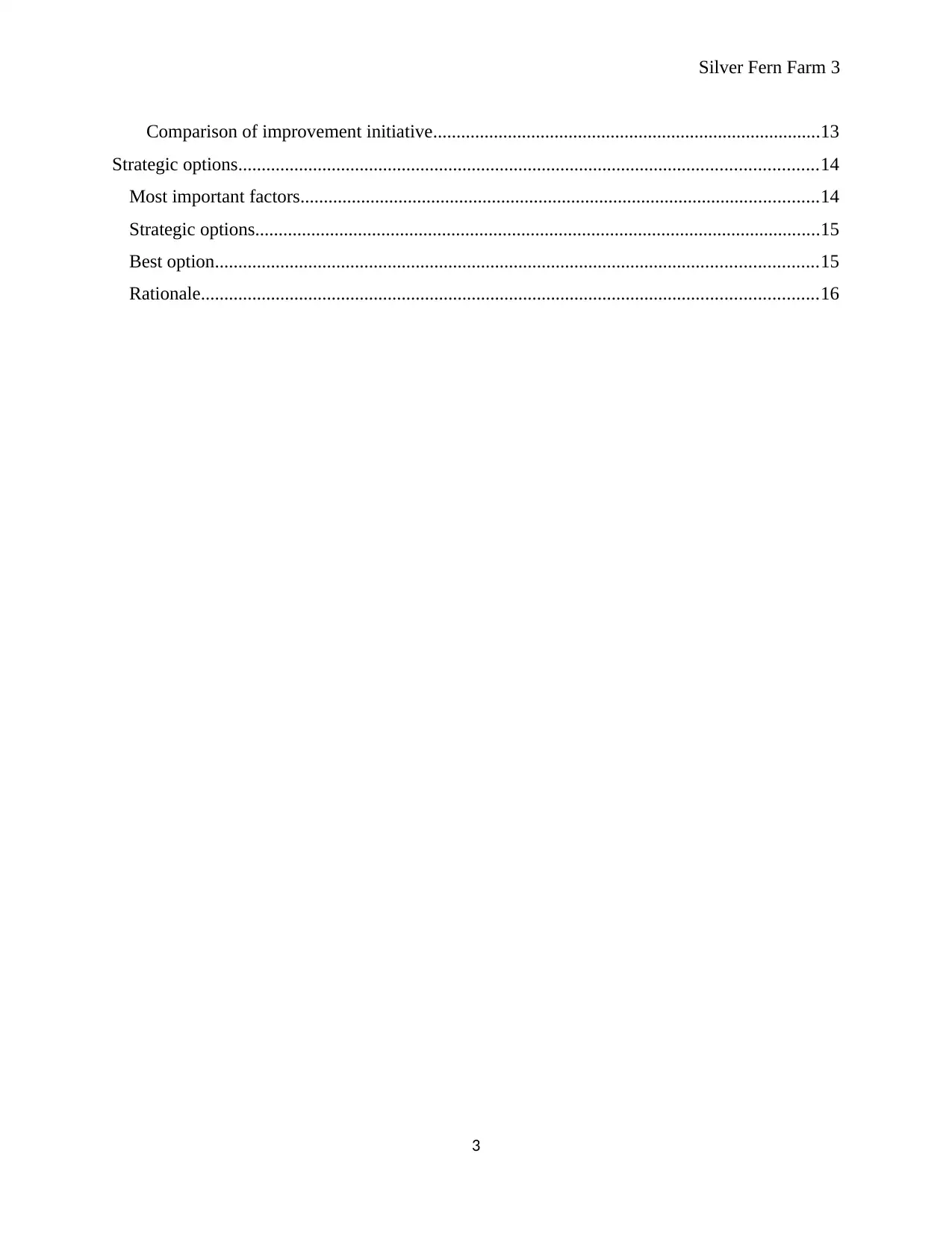
Silver Fern Farm 3
Comparison of improvement initiative...................................................................................13
Strategic options............................................................................................................................14
Most important factors...............................................................................................................14
Strategic options.........................................................................................................................15
Best option.................................................................................................................................15
Rationale....................................................................................................................................16
3
Comparison of improvement initiative...................................................................................13
Strategic options............................................................................................................................14
Most important factors...............................................................................................................14
Strategic options.........................................................................................................................15
Best option.................................................................................................................................15
Rationale....................................................................................................................................16
3
⊘ This is a preview!⊘
Do you want full access?
Subscribe today to unlock all pages.

Trusted by 1+ million students worldwide
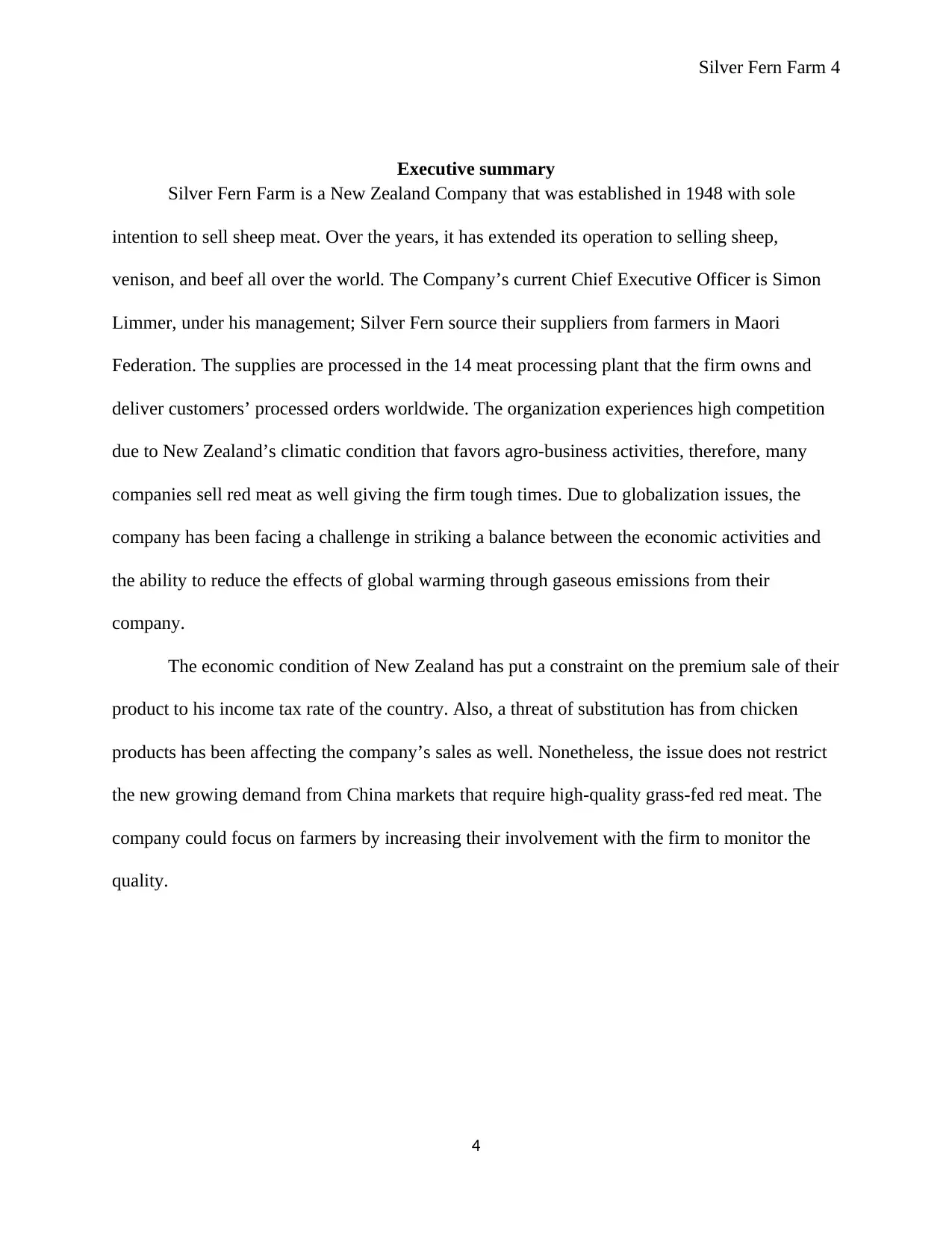
Silver Fern Farm 4
Executive summary
Silver Fern Farm is a New Zealand Company that was established in 1948 with sole
intention to sell sheep meat. Over the years, it has extended its operation to selling sheep,
venison, and beef all over the world. The Company’s current Chief Executive Officer is Simon
Limmer, under his management; Silver Fern source their suppliers from farmers in Maori
Federation. The supplies are processed in the 14 meat processing plant that the firm owns and
deliver customers’ processed orders worldwide. The organization experiences high competition
due to New Zealand’s climatic condition that favors agro-business activities, therefore, many
companies sell red meat as well giving the firm tough times. Due to globalization issues, the
company has been facing a challenge in striking a balance between the economic activities and
the ability to reduce the effects of global warming through gaseous emissions from their
company.
The economic condition of New Zealand has put a constraint on the premium sale of their
product to his income tax rate of the country. Also, a threat of substitution has from chicken
products has been affecting the company’s sales as well. Nonetheless, the issue does not restrict
the new growing demand from China markets that require high-quality grass-fed red meat. The
company could focus on farmers by increasing their involvement with the firm to monitor the
quality.
4
Executive summary
Silver Fern Farm is a New Zealand Company that was established in 1948 with sole
intention to sell sheep meat. Over the years, it has extended its operation to selling sheep,
venison, and beef all over the world. The Company’s current Chief Executive Officer is Simon
Limmer, under his management; Silver Fern source their suppliers from farmers in Maori
Federation. The supplies are processed in the 14 meat processing plant that the firm owns and
deliver customers’ processed orders worldwide. The organization experiences high competition
due to New Zealand’s climatic condition that favors agro-business activities, therefore, many
companies sell red meat as well giving the firm tough times. Due to globalization issues, the
company has been facing a challenge in striking a balance between the economic activities and
the ability to reduce the effects of global warming through gaseous emissions from their
company.
The economic condition of New Zealand has put a constraint on the premium sale of their
product to his income tax rate of the country. Also, a threat of substitution has from chicken
products has been affecting the company’s sales as well. Nonetheless, the issue does not restrict
the new growing demand from China markets that require high-quality grass-fed red meat. The
company could focus on farmers by increasing their involvement with the firm to monitor the
quality.
4
Paraphrase This Document
Need a fresh take? Get an instant paraphrase of this document with our AI Paraphraser
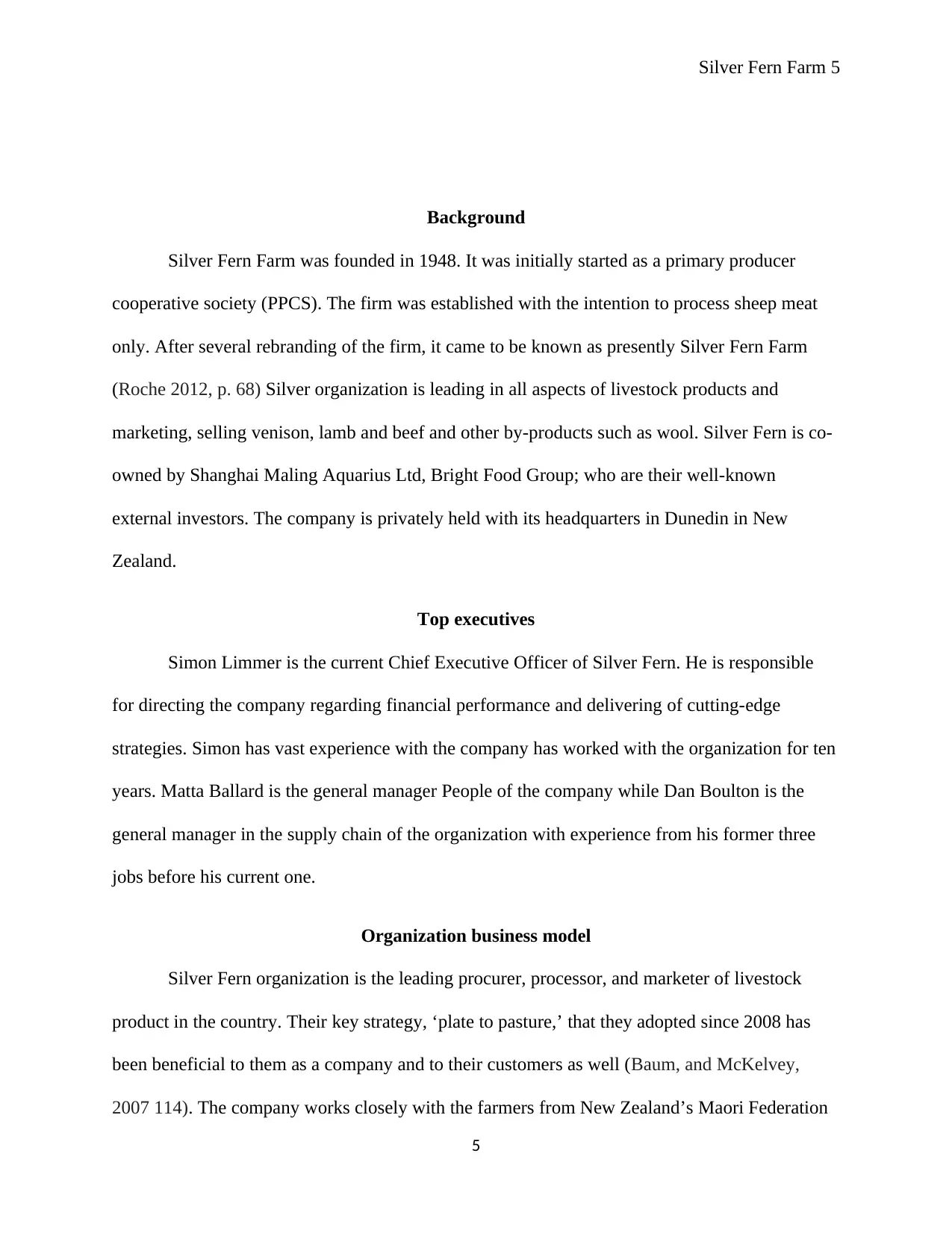
Silver Fern Farm 5
Background
Silver Fern Farm was founded in 1948. It was initially started as a primary producer
cooperative society (PPCS). The firm was established with the intention to process sheep meat
only. After several rebranding of the firm, it came to be known as presently Silver Fern Farm
(Roche 2012, p. 68) Silver organization is leading in all aspects of livestock products and
marketing, selling venison, lamb and beef and other by-products such as wool. Silver Fern is co-
owned by Shanghai Maling Aquarius Ltd, Bright Food Group; who are their well-known
external investors. The company is privately held with its headquarters in Dunedin in New
Zealand.
Top executives
Simon Limmer is the current Chief Executive Officer of Silver Fern. He is responsible
for directing the company regarding financial performance and delivering of cutting-edge
strategies. Simon has vast experience with the company has worked with the organization for ten
years. Matta Ballard is the general manager People of the company while Dan Boulton is the
general manager in the supply chain of the organization with experience from his former three
jobs before his current one.
Organization business model
Silver Fern organization is the leading procurer, processor, and marketer of livestock
product in the country. Their key strategy, ‘plate to pasture,’ that they adopted since 2008 has
been beneficial to them as a company and to their customers as well (Baum, and McKelvey,
2007 114). The company works closely with the farmers from New Zealand’s Maori Federation
5
Background
Silver Fern Farm was founded in 1948. It was initially started as a primary producer
cooperative society (PPCS). The firm was established with the intention to process sheep meat
only. After several rebranding of the firm, it came to be known as presently Silver Fern Farm
(Roche 2012, p. 68) Silver organization is leading in all aspects of livestock products and
marketing, selling venison, lamb and beef and other by-products such as wool. Silver Fern is co-
owned by Shanghai Maling Aquarius Ltd, Bright Food Group; who are their well-known
external investors. The company is privately held with its headquarters in Dunedin in New
Zealand.
Top executives
Simon Limmer is the current Chief Executive Officer of Silver Fern. He is responsible
for directing the company regarding financial performance and delivering of cutting-edge
strategies. Simon has vast experience with the company has worked with the organization for ten
years. Matta Ballard is the general manager People of the company while Dan Boulton is the
general manager in the supply chain of the organization with experience from his former three
jobs before his current one.
Organization business model
Silver Fern organization is the leading procurer, processor, and marketer of livestock
product in the country. Their key strategy, ‘plate to pasture,’ that they adopted since 2008 has
been beneficial to them as a company and to their customers as well (Baum, and McKelvey,
2007 114). The company works closely with the farmers from New Zealand’s Maori Federation
5
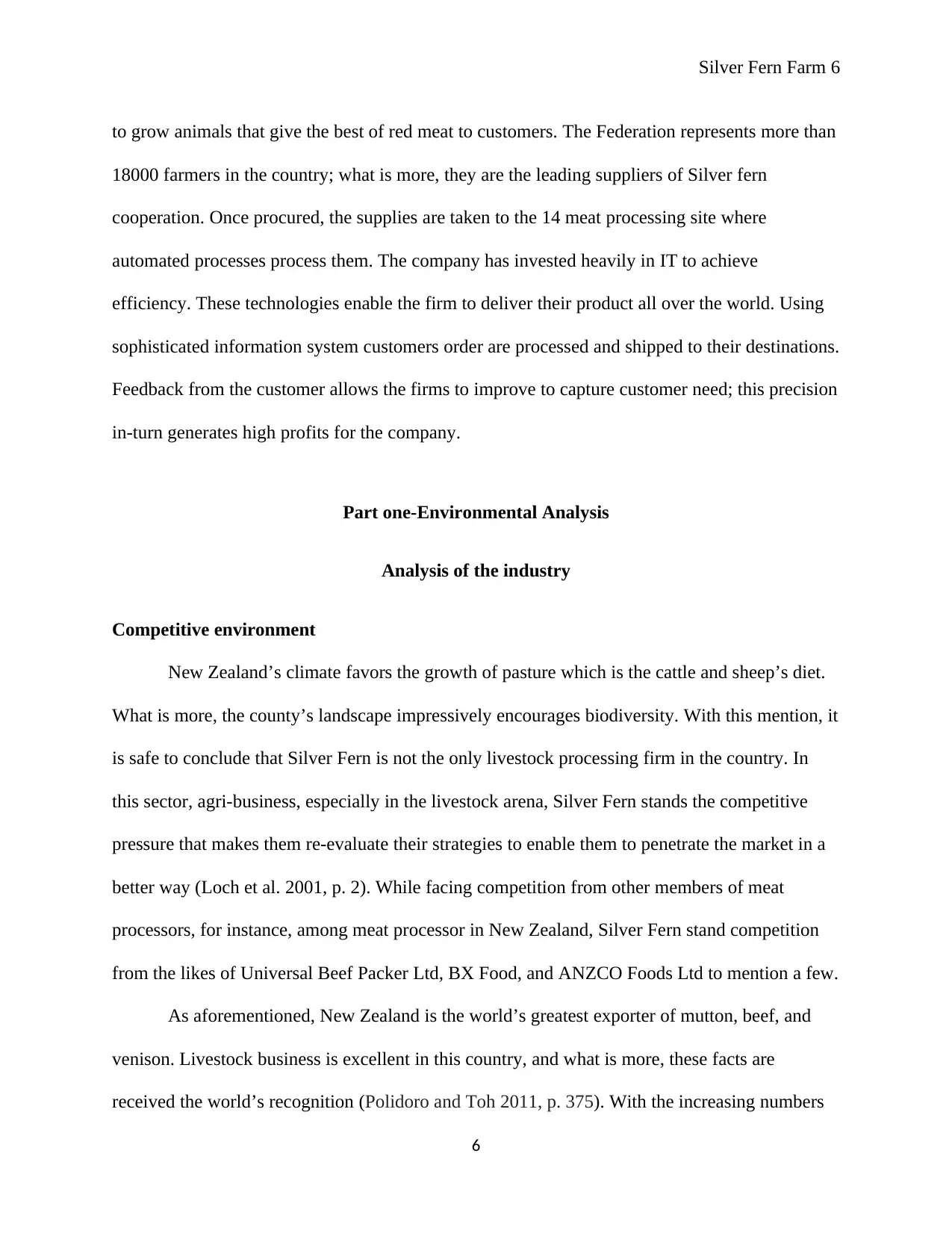
Silver Fern Farm 6
to grow animals that give the best of red meat to customers. The Federation represents more than
18000 farmers in the country; what is more, they are the leading suppliers of Silver fern
cooperation. Once procured, the supplies are taken to the 14 meat processing site where
automated processes process them. The company has invested heavily in IT to achieve
efficiency. These technologies enable the firm to deliver their product all over the world. Using
sophisticated information system customers order are processed and shipped to their destinations.
Feedback from the customer allows the firms to improve to capture customer need; this precision
in-turn generates high profits for the company.
Part one-Environmental Analysis
Analysis of the industry
Competitive environment
New Zealand’s climate favors the growth of pasture which is the cattle and sheep’s diet.
What is more, the county’s landscape impressively encourages biodiversity. With this mention, it
is safe to conclude that Silver Fern is not the only livestock processing firm in the country. In
this sector, agri-business, especially in the livestock arena, Silver Fern stands the competitive
pressure that makes them re-evaluate their strategies to enable them to penetrate the market in a
better way (Loch et al. 2001, p. 2). While facing competition from other members of meat
processors, for instance, among meat processor in New Zealand, Silver Fern stand competition
from the likes of Universal Beef Packer Ltd, BX Food, and ANZCO Foods Ltd to mention a few.
As aforementioned, New Zealand is the world’s greatest exporter of mutton, beef, and
venison. Livestock business is excellent in this country, and what is more, these facts are
received the world’s recognition (Polidoro and Toh 2011, p. 375). With the increasing numbers
6
to grow animals that give the best of red meat to customers. The Federation represents more than
18000 farmers in the country; what is more, they are the leading suppliers of Silver fern
cooperation. Once procured, the supplies are taken to the 14 meat processing site where
automated processes process them. The company has invested heavily in IT to achieve
efficiency. These technologies enable the firm to deliver their product all over the world. Using
sophisticated information system customers order are processed and shipped to their destinations.
Feedback from the customer allows the firms to improve to capture customer need; this precision
in-turn generates high profits for the company.
Part one-Environmental Analysis
Analysis of the industry
Competitive environment
New Zealand’s climate favors the growth of pasture which is the cattle and sheep’s diet.
What is more, the county’s landscape impressively encourages biodiversity. With this mention, it
is safe to conclude that Silver Fern is not the only livestock processing firm in the country. In
this sector, agri-business, especially in the livestock arena, Silver Fern stands the competitive
pressure that makes them re-evaluate their strategies to enable them to penetrate the market in a
better way (Loch et al. 2001, p. 2). While facing competition from other members of meat
processors, for instance, among meat processor in New Zealand, Silver Fern stand competition
from the likes of Universal Beef Packer Ltd, BX Food, and ANZCO Foods Ltd to mention a few.
As aforementioned, New Zealand is the world’s greatest exporter of mutton, beef, and
venison. Livestock business is excellent in this country, and what is more, these facts are
received the world’s recognition (Polidoro and Toh 2011, p. 375). With the increasing numbers
6
⊘ This is a preview!⊘
Do you want full access?
Subscribe today to unlock all pages.

Trusted by 1+ million students worldwide
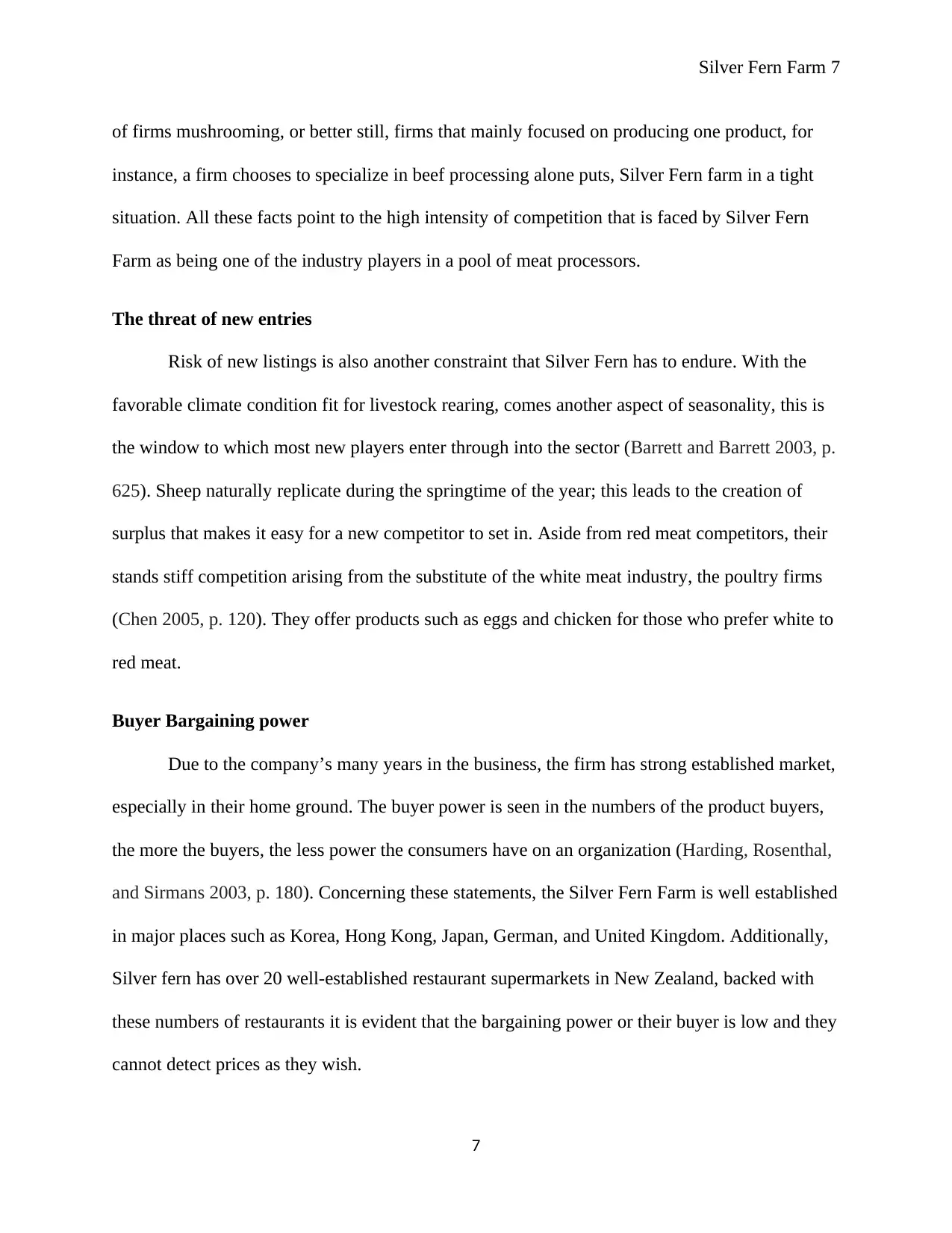
Silver Fern Farm 7
of firms mushrooming, or better still, firms that mainly focused on producing one product, for
instance, a firm chooses to specialize in beef processing alone puts, Silver Fern farm in a tight
situation. All these facts point to the high intensity of competition that is faced by Silver Fern
Farm as being one of the industry players in a pool of meat processors.
The threat of new entries
Risk of new listings is also another constraint that Silver Fern has to endure. With the
favorable climate condition fit for livestock rearing, comes another aspect of seasonality, this is
the window to which most new players enter through into the sector (Barrett and Barrett 2003, p.
625). Sheep naturally replicate during the springtime of the year; this leads to the creation of
surplus that makes it easy for a new competitor to set in. Aside from red meat competitors, their
stands stiff competition arising from the substitute of the white meat industry, the poultry firms
(Chen 2005, p. 120). They offer products such as eggs and chicken for those who prefer white to
red meat.
Buyer Bargaining power
Due to the company’s many years in the business, the firm has strong established market,
especially in their home ground. The buyer power is seen in the numbers of the product buyers,
the more the buyers, the less power the consumers have on an organization (Harding, Rosenthal,
and Sirmans 2003, p. 180). Concerning these statements, the Silver Fern Farm is well established
in major places such as Korea, Hong Kong, Japan, German, and United Kingdom. Additionally,
Silver fern has over 20 well-established restaurant supermarkets in New Zealand, backed with
these numbers of restaurants it is evident that the bargaining power or their buyer is low and they
cannot detect prices as they wish.
7
of firms mushrooming, or better still, firms that mainly focused on producing one product, for
instance, a firm chooses to specialize in beef processing alone puts, Silver Fern farm in a tight
situation. All these facts point to the high intensity of competition that is faced by Silver Fern
Farm as being one of the industry players in a pool of meat processors.
The threat of new entries
Risk of new listings is also another constraint that Silver Fern has to endure. With the
favorable climate condition fit for livestock rearing, comes another aspect of seasonality, this is
the window to which most new players enter through into the sector (Barrett and Barrett 2003, p.
625). Sheep naturally replicate during the springtime of the year; this leads to the creation of
surplus that makes it easy for a new competitor to set in. Aside from red meat competitors, their
stands stiff competition arising from the substitute of the white meat industry, the poultry firms
(Chen 2005, p. 120). They offer products such as eggs and chicken for those who prefer white to
red meat.
Buyer Bargaining power
Due to the company’s many years in the business, the firm has strong established market,
especially in their home ground. The buyer power is seen in the numbers of the product buyers,
the more the buyers, the less power the consumers have on an organization (Harding, Rosenthal,
and Sirmans 2003, p. 180). Concerning these statements, the Silver Fern Farm is well established
in major places such as Korea, Hong Kong, Japan, German, and United Kingdom. Additionally,
Silver fern has over 20 well-established restaurant supermarkets in New Zealand, backed with
these numbers of restaurants it is evident that the bargaining power or their buyer is low and they
cannot detect prices as they wish.
7
Paraphrase This Document
Need a fresh take? Get an instant paraphrase of this document with our AI Paraphraser
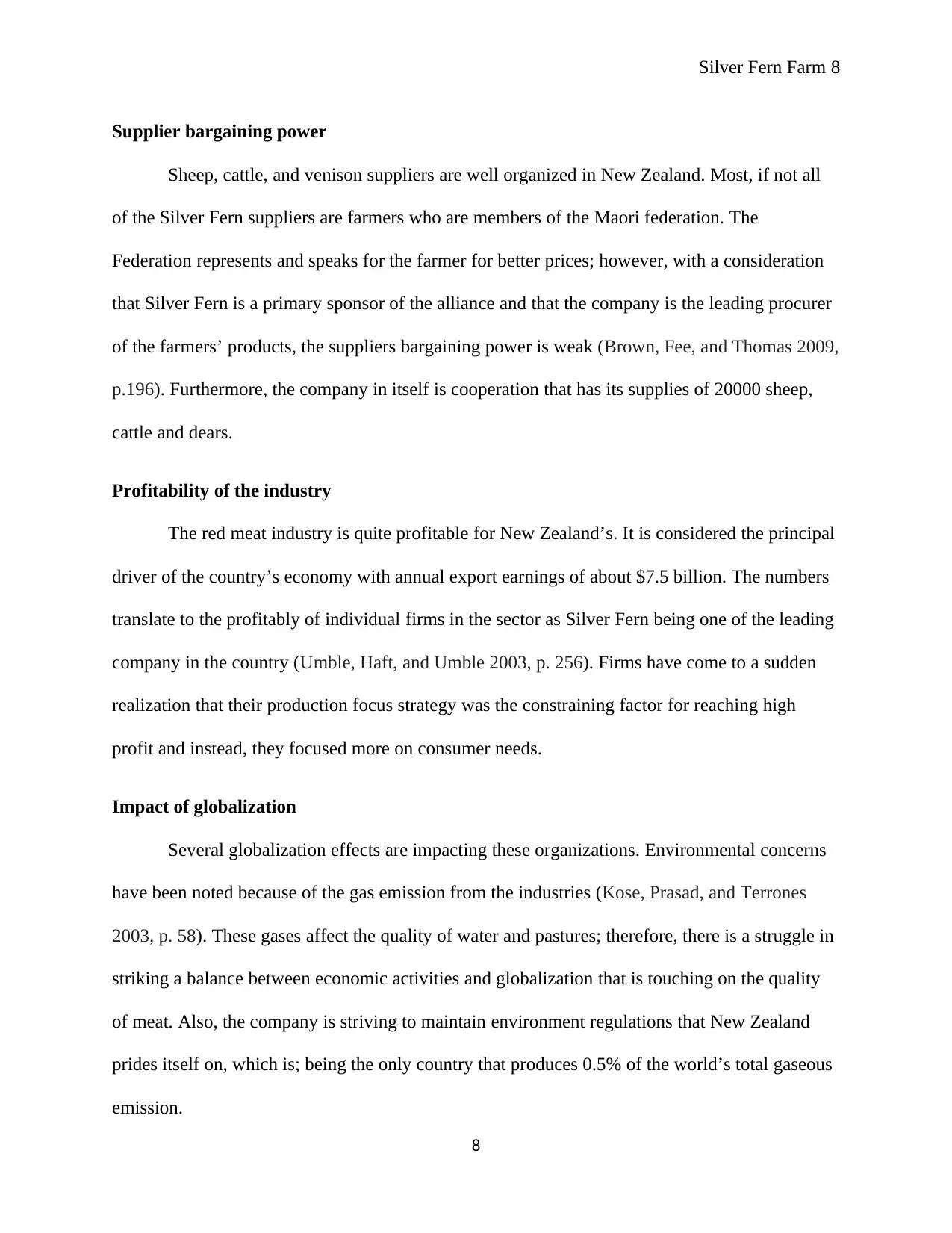
Silver Fern Farm 8
Supplier bargaining power
Sheep, cattle, and venison suppliers are well organized in New Zealand. Most, if not all
of the Silver Fern suppliers are farmers who are members of the Maori federation. The
Federation represents and speaks for the farmer for better prices; however, with a consideration
that Silver Fern is a primary sponsor of the alliance and that the company is the leading procurer
of the farmers’ products, the suppliers bargaining power is weak (Brown, Fee, and Thomas 2009,
p.196). Furthermore, the company in itself is cooperation that has its supplies of 20000 sheep,
cattle and dears.
Profitability of the industry
The red meat industry is quite profitable for New Zealand’s. It is considered the principal
driver of the country’s economy with annual export earnings of about $7.5 billion. The numbers
translate to the profitably of individual firms in the sector as Silver Fern being one of the leading
company in the country (Umble, Haft, and Umble 2003, p. 256). Firms have come to a sudden
realization that their production focus strategy was the constraining factor for reaching high
profit and instead, they focused more on consumer needs.
Impact of globalization
Several globalization effects are impacting these organizations. Environmental concerns
have been noted because of the gas emission from the industries (Kose, Prasad, and Terrones
2003, p. 58). These gases affect the quality of water and pastures; therefore, there is a struggle in
striking a balance between economic activities and globalization that is touching on the quality
of meat. Also, the company is striving to maintain environment regulations that New Zealand
prides itself on, which is; being the only country that produces 0.5% of the world’s total gaseous
emission.
8
Supplier bargaining power
Sheep, cattle, and venison suppliers are well organized in New Zealand. Most, if not all
of the Silver Fern suppliers are farmers who are members of the Maori federation. The
Federation represents and speaks for the farmer for better prices; however, with a consideration
that Silver Fern is a primary sponsor of the alliance and that the company is the leading procurer
of the farmers’ products, the suppliers bargaining power is weak (Brown, Fee, and Thomas 2009,
p.196). Furthermore, the company in itself is cooperation that has its supplies of 20000 sheep,
cattle and dears.
Profitability of the industry
The red meat industry is quite profitable for New Zealand’s. It is considered the principal
driver of the country’s economy with annual export earnings of about $7.5 billion. The numbers
translate to the profitably of individual firms in the sector as Silver Fern being one of the leading
company in the country (Umble, Haft, and Umble 2003, p. 256). Firms have come to a sudden
realization that their production focus strategy was the constraining factor for reaching high
profit and instead, they focused more on consumer needs.
Impact of globalization
Several globalization effects are impacting these organizations. Environmental concerns
have been noted because of the gas emission from the industries (Kose, Prasad, and Terrones
2003, p. 58). These gases affect the quality of water and pastures; therefore, there is a struggle in
striking a balance between economic activities and globalization that is touching on the quality
of meat. Also, the company is striving to maintain environment regulations that New Zealand
prides itself on, which is; being the only country that produces 0.5% of the world’s total gaseous
emission.
8
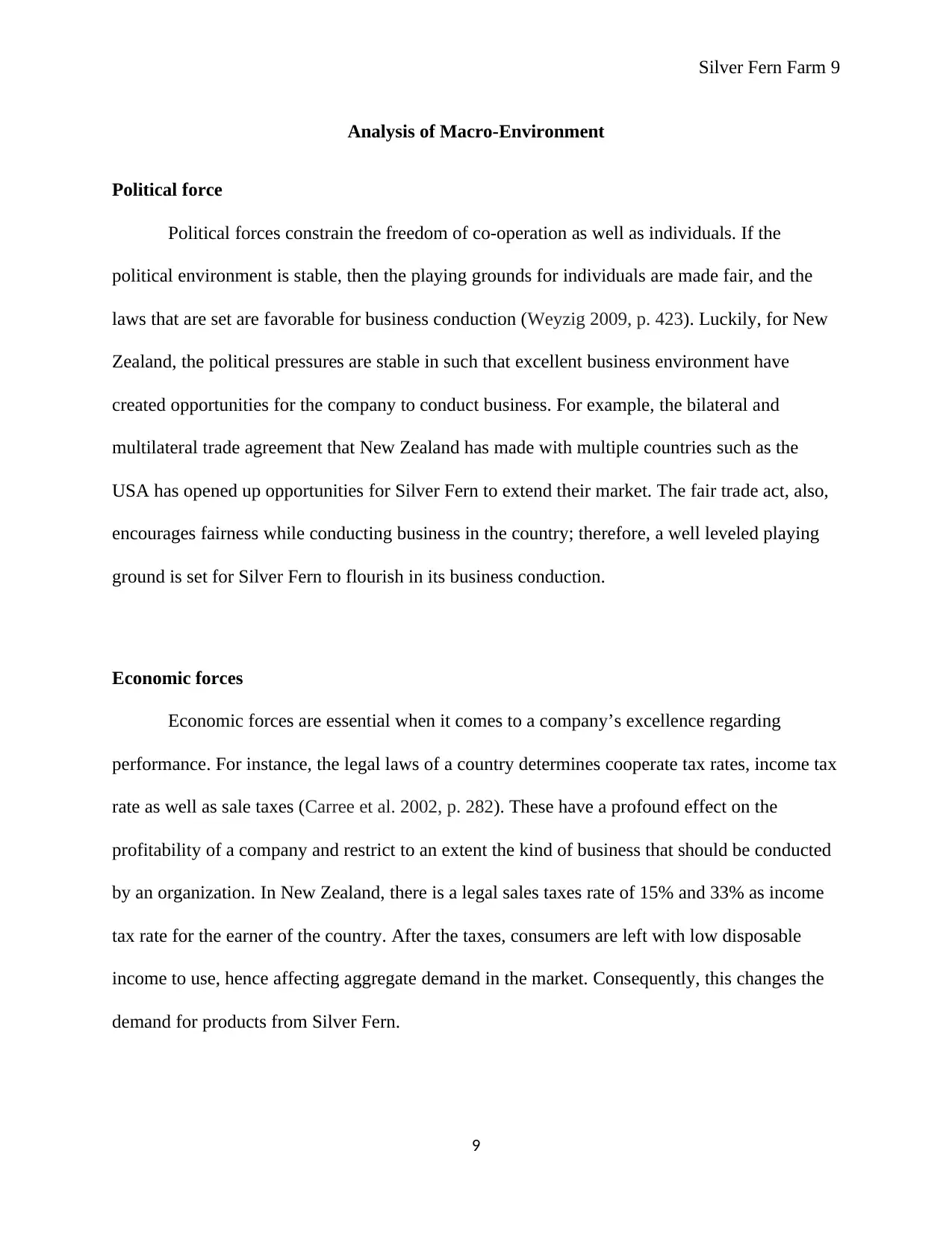
Silver Fern Farm 9
Analysis of Macro-Environment
Political force
Political forces constrain the freedom of co-operation as well as individuals. If the
political environment is stable, then the playing grounds for individuals are made fair, and the
laws that are set are favorable for business conduction (Weyzig 2009, p. 423). Luckily, for New
Zealand, the political pressures are stable in such that excellent business environment have
created opportunities for the company to conduct business. For example, the bilateral and
multilateral trade agreement that New Zealand has made with multiple countries such as the
USA has opened up opportunities for Silver Fern to extend their market. The fair trade act, also,
encourages fairness while conducting business in the country; therefore, a well leveled playing
ground is set for Silver Fern to flourish in its business conduction.
Economic forces
Economic forces are essential when it comes to a company’s excellence regarding
performance. For instance, the legal laws of a country determines cooperate tax rates, income tax
rate as well as sale taxes (Carree et al. 2002, p. 282). These have a profound effect on the
profitability of a company and restrict to an extent the kind of business that should be conducted
by an organization. In New Zealand, there is a legal sales taxes rate of 15% and 33% as income
tax rate for the earner of the country. After the taxes, consumers are left with low disposable
income to use, hence affecting aggregate demand in the market. Consequently, this changes the
demand for products from Silver Fern.
9
Analysis of Macro-Environment
Political force
Political forces constrain the freedom of co-operation as well as individuals. If the
political environment is stable, then the playing grounds for individuals are made fair, and the
laws that are set are favorable for business conduction (Weyzig 2009, p. 423). Luckily, for New
Zealand, the political pressures are stable in such that excellent business environment have
created opportunities for the company to conduct business. For example, the bilateral and
multilateral trade agreement that New Zealand has made with multiple countries such as the
USA has opened up opportunities for Silver Fern to extend their market. The fair trade act, also,
encourages fairness while conducting business in the country; therefore, a well leveled playing
ground is set for Silver Fern to flourish in its business conduction.
Economic forces
Economic forces are essential when it comes to a company’s excellence regarding
performance. For instance, the legal laws of a country determines cooperate tax rates, income tax
rate as well as sale taxes (Carree et al. 2002, p. 282). These have a profound effect on the
profitability of a company and restrict to an extent the kind of business that should be conducted
by an organization. In New Zealand, there is a legal sales taxes rate of 15% and 33% as income
tax rate for the earner of the country. After the taxes, consumers are left with low disposable
income to use, hence affecting aggregate demand in the market. Consequently, this changes the
demand for products from Silver Fern.
9
⊘ This is a preview!⊘
Do you want full access?
Subscribe today to unlock all pages.

Trusted by 1+ million students worldwide
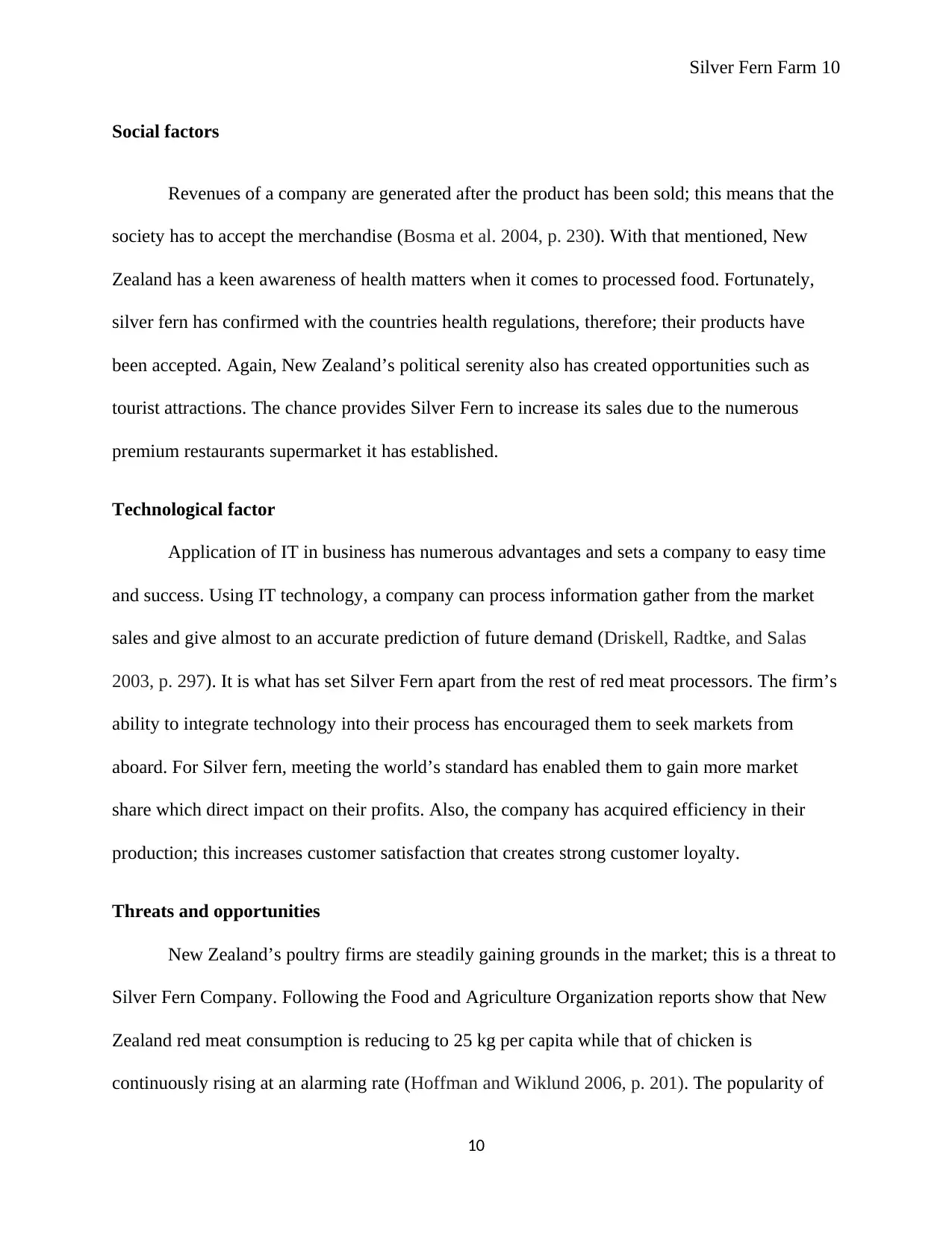
Silver Fern Farm 10
Social factors
Revenues of a company are generated after the product has been sold; this means that the
society has to accept the merchandise (Bosma et al. 2004, p. 230). With that mentioned, New
Zealand has a keen awareness of health matters when it comes to processed food. Fortunately,
silver fern has confirmed with the countries health regulations, therefore; their products have
been accepted. Again, New Zealand’s political serenity also has created opportunities such as
tourist attractions. The chance provides Silver Fern to increase its sales due to the numerous
premium restaurants supermarket it has established.
Technological factor
Application of IT in business has numerous advantages and sets a company to easy time
and success. Using IT technology, a company can process information gather from the market
sales and give almost to an accurate prediction of future demand (Driskell, Radtke, and Salas
2003, p. 297). It is what has set Silver Fern apart from the rest of red meat processors. The firm’s
ability to integrate technology into their process has encouraged them to seek markets from
aboard. For Silver fern, meeting the world’s standard has enabled them to gain more market
share which direct impact on their profits. Also, the company has acquired efficiency in their
production; this increases customer satisfaction that creates strong customer loyalty.
Threats and opportunities
New Zealand’s poultry firms are steadily gaining grounds in the market; this is a threat to
Silver Fern Company. Following the Food and Agriculture Organization reports show that New
Zealand red meat consumption is reducing to 25 kg per capita while that of chicken is
continuously rising at an alarming rate (Hoffman and Wiklund 2006, p. 201). The popularity of
10
Social factors
Revenues of a company are generated after the product has been sold; this means that the
society has to accept the merchandise (Bosma et al. 2004, p. 230). With that mentioned, New
Zealand has a keen awareness of health matters when it comes to processed food. Fortunately,
silver fern has confirmed with the countries health regulations, therefore; their products have
been accepted. Again, New Zealand’s political serenity also has created opportunities such as
tourist attractions. The chance provides Silver Fern to increase its sales due to the numerous
premium restaurants supermarket it has established.
Technological factor
Application of IT in business has numerous advantages and sets a company to easy time
and success. Using IT technology, a company can process information gather from the market
sales and give almost to an accurate prediction of future demand (Driskell, Radtke, and Salas
2003, p. 297). It is what has set Silver Fern apart from the rest of red meat processors. The firm’s
ability to integrate technology into their process has encouraged them to seek markets from
aboard. For Silver fern, meeting the world’s standard has enabled them to gain more market
share which direct impact on their profits. Also, the company has acquired efficiency in their
production; this increases customer satisfaction that creates strong customer loyalty.
Threats and opportunities
New Zealand’s poultry firms are steadily gaining grounds in the market; this is a threat to
Silver Fern Company. Following the Food and Agriculture Organization reports show that New
Zealand red meat consumption is reducing to 25 kg per capita while that of chicken is
continuously rising at an alarming rate (Hoffman and Wiklund 2006, p. 201). The popularity of
10
Paraphrase This Document
Need a fresh take? Get an instant paraphrase of this document with our AI Paraphraser
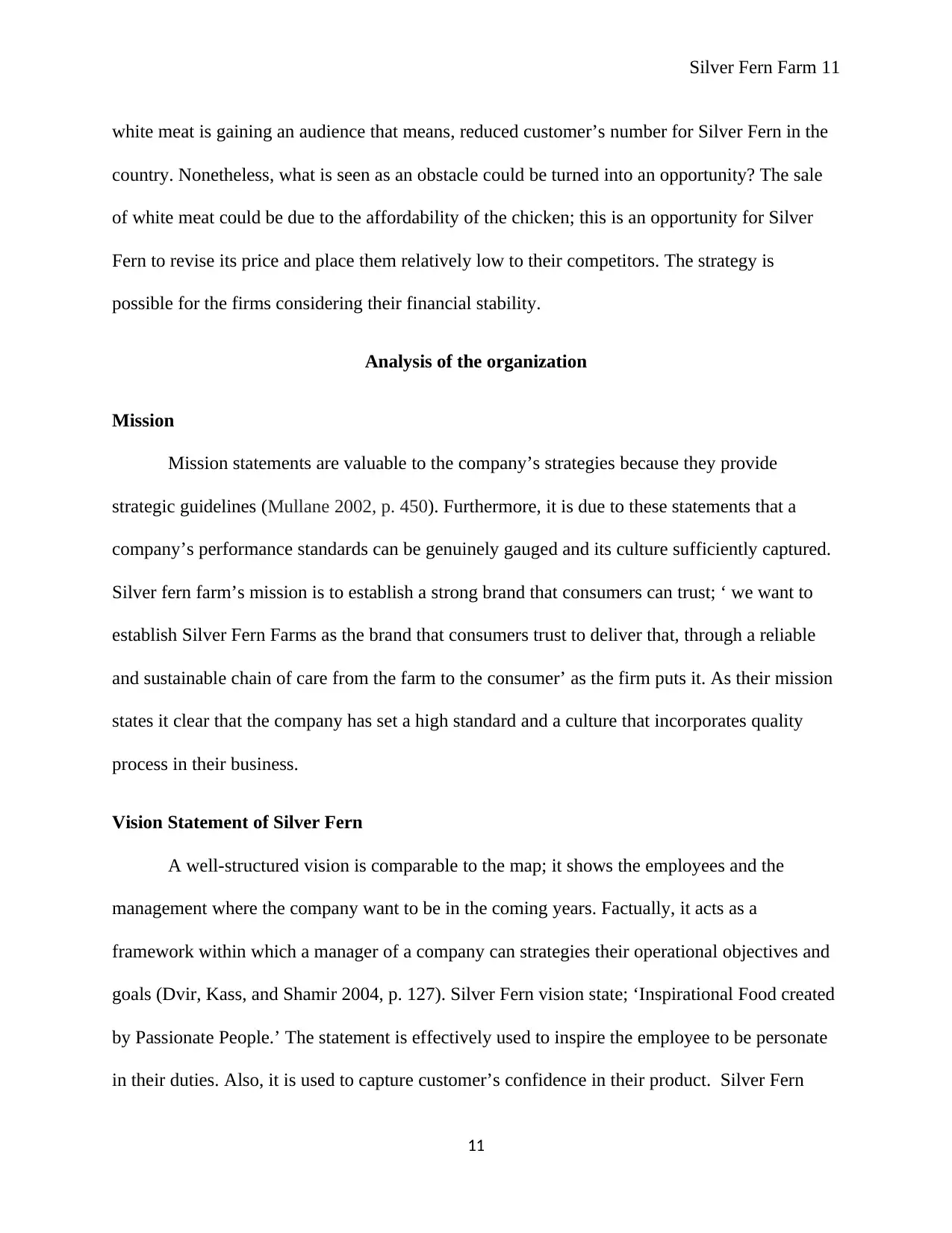
Silver Fern Farm 11
white meat is gaining an audience that means, reduced customer’s number for Silver Fern in the
country. Nonetheless, what is seen as an obstacle could be turned into an opportunity? The sale
of white meat could be due to the affordability of the chicken; this is an opportunity for Silver
Fern to revise its price and place them relatively low to their competitors. The strategy is
possible for the firms considering their financial stability.
Analysis of the organization
Mission
Mission statements are valuable to the company’s strategies because they provide
strategic guidelines (Mullane 2002, p. 450). Furthermore, it is due to these statements that a
company’s performance standards can be genuinely gauged and its culture sufficiently captured.
Silver fern farm’s mission is to establish a strong brand that consumers can trust; ‘ we want to
establish Silver Fern Farms as the brand that consumers trust to deliver that, through a reliable
and sustainable chain of care from the farm to the consumer’ as the firm puts it. As their mission
states it clear that the company has set a high standard and a culture that incorporates quality
process in their business.
Vision Statement of Silver Fern
A well-structured vision is comparable to the map; it shows the employees and the
management where the company want to be in the coming years. Factually, it acts as a
framework within which a manager of a company can strategies their operational objectives and
goals (Dvir, Kass, and Shamir 2004, p. 127). Silver Fern vision state; ‘Inspirational Food created
by Passionate People.’ The statement is effectively used to inspire the employee to be personate
in their duties. Also, it is used to capture customer’s confidence in their product. Silver Fern
11
white meat is gaining an audience that means, reduced customer’s number for Silver Fern in the
country. Nonetheless, what is seen as an obstacle could be turned into an opportunity? The sale
of white meat could be due to the affordability of the chicken; this is an opportunity for Silver
Fern to revise its price and place them relatively low to their competitors. The strategy is
possible for the firms considering their financial stability.
Analysis of the organization
Mission
Mission statements are valuable to the company’s strategies because they provide
strategic guidelines (Mullane 2002, p. 450). Furthermore, it is due to these statements that a
company’s performance standards can be genuinely gauged and its culture sufficiently captured.
Silver fern farm’s mission is to establish a strong brand that consumers can trust; ‘ we want to
establish Silver Fern Farms as the brand that consumers trust to deliver that, through a reliable
and sustainable chain of care from the farm to the consumer’ as the firm puts it. As their mission
states it clear that the company has set a high standard and a culture that incorporates quality
process in their business.
Vision Statement of Silver Fern
A well-structured vision is comparable to the map; it shows the employees and the
management where the company want to be in the coming years. Factually, it acts as a
framework within which a manager of a company can strategies their operational objectives and
goals (Dvir, Kass, and Shamir 2004, p. 127). Silver Fern vision state; ‘Inspirational Food created
by Passionate People.’ The statement is effectively used to inspire the employee to be personate
in their duties. Also, it is used to capture customer’s confidence in their product. Silver Fern
11
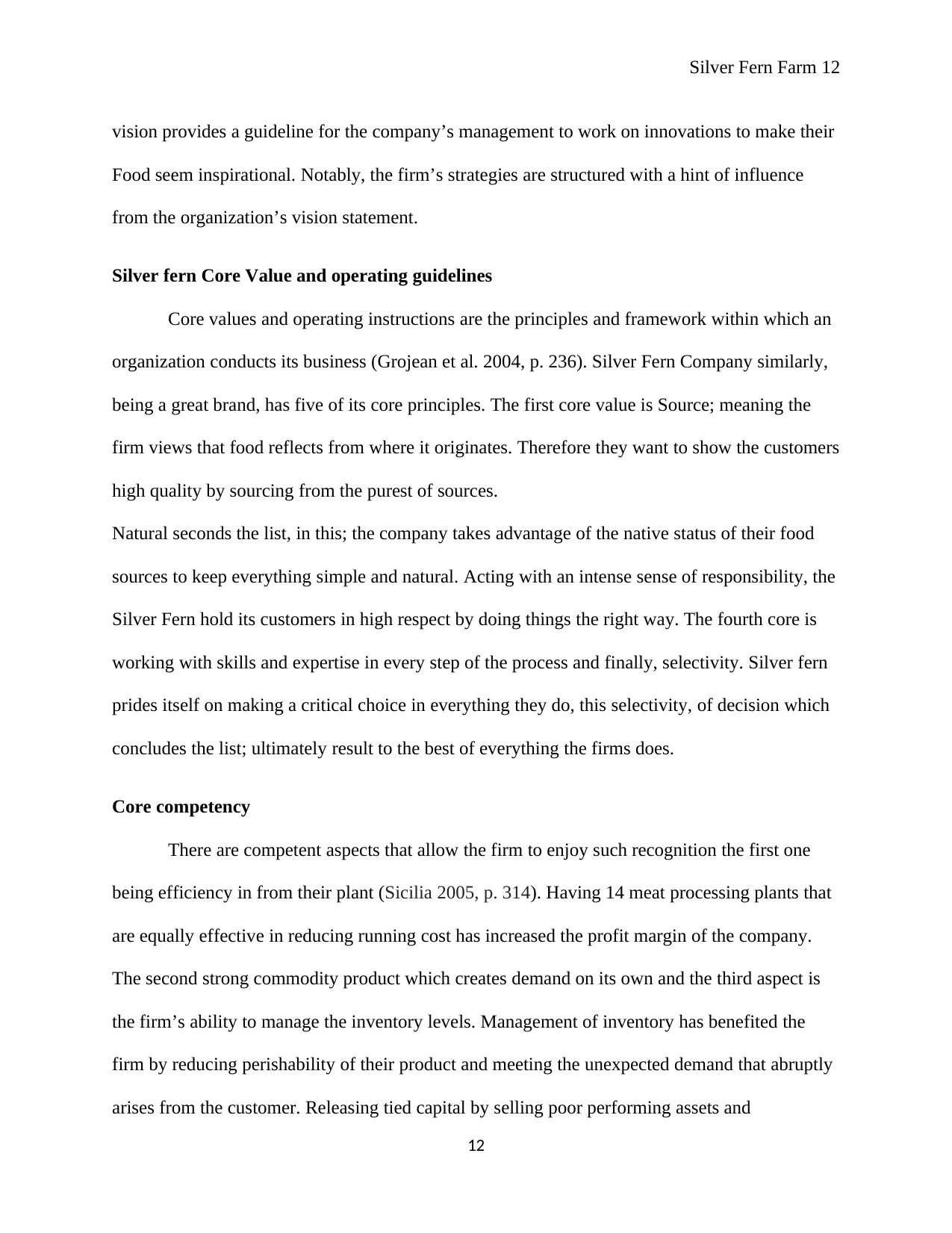
Silver Fern Farm 12
vision provides a guideline for the company’s management to work on innovations to make their
Food seem inspirational. Notably, the firm’s strategies are structured with a hint of influence
from the organization’s vision statement.
Silver fern Core Value and operating guidelines
Core values and operating instructions are the principles and framework within which an
organization conducts its business (Grojean et al. 2004, p. 236). Silver Fern Company similarly,
being a great brand, has five of its core principles. The first core value is Source; meaning the
firm views that food reflects from where it originates. Therefore they want to show the customers
high quality by sourcing from the purest of sources.
Natural seconds the list, in this; the company takes advantage of the native status of their food
sources to keep everything simple and natural. Acting with an intense sense of responsibility, the
Silver Fern hold its customers in high respect by doing things the right way. The fourth core is
working with skills and expertise in every step of the process and finally, selectivity. Silver fern
prides itself on making a critical choice in everything they do, this selectivity, of decision which
concludes the list; ultimately result to the best of everything the firms does.
Core competency
There are competent aspects that allow the firm to enjoy such recognition the first one
being efficiency in from their plant (Sicilia 2005, p. 314). Having 14 meat processing plants that
are equally effective in reducing running cost has increased the profit margin of the company.
The second strong commodity product which creates demand on its own and the third aspect is
the firm’s ability to manage the inventory levels. Management of inventory has benefited the
firm by reducing perishability of their product and meeting the unexpected demand that abruptly
arises from the customer. Releasing tied capital by selling poor performing assets and
12
vision provides a guideline for the company’s management to work on innovations to make their
Food seem inspirational. Notably, the firm’s strategies are structured with a hint of influence
from the organization’s vision statement.
Silver fern Core Value and operating guidelines
Core values and operating instructions are the principles and framework within which an
organization conducts its business (Grojean et al. 2004, p. 236). Silver Fern Company similarly,
being a great brand, has five of its core principles. The first core value is Source; meaning the
firm views that food reflects from where it originates. Therefore they want to show the customers
high quality by sourcing from the purest of sources.
Natural seconds the list, in this; the company takes advantage of the native status of their food
sources to keep everything simple and natural. Acting with an intense sense of responsibility, the
Silver Fern hold its customers in high respect by doing things the right way. The fourth core is
working with skills and expertise in every step of the process and finally, selectivity. Silver fern
prides itself on making a critical choice in everything they do, this selectivity, of decision which
concludes the list; ultimately result to the best of everything the firms does.
Core competency
There are competent aspects that allow the firm to enjoy such recognition the first one
being efficiency in from their plant (Sicilia 2005, p. 314). Having 14 meat processing plants that
are equally effective in reducing running cost has increased the profit margin of the company.
The second strong commodity product which creates demand on its own and the third aspect is
the firm’s ability to manage the inventory levels. Management of inventory has benefited the
firm by reducing perishability of their product and meeting the unexpected demand that abruptly
arises from the customer. Releasing tied capital by selling poor performing assets and
12
⊘ This is a preview!⊘
Do you want full access?
Subscribe today to unlock all pages.

Trusted by 1+ million students worldwide
1 out of 23
Related Documents
Your All-in-One AI-Powered Toolkit for Academic Success.
+13062052269
info@desklib.com
Available 24*7 on WhatsApp / Email
![[object Object]](/_next/static/media/star-bottom.7253800d.svg)
Unlock your academic potential
Copyright © 2020–2025 A2Z Services. All Rights Reserved. Developed and managed by ZUCOL.





